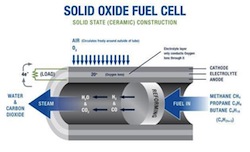The Office of Naval Research (ONR) recently demonstrated some of its new technology for tactical generators designed to cut fuel use nearly in half compared to diesel system currently powering forward-operating bases.
According to a post on the Navy’s website, the Solid-Oxide Fuel Cell Tactical Electrical Power Unit’s goal is to reduce the need to transport fuel around the battlefield, especially  in dangerous locations like Afghanistan. The solid-oxide fuel cell produces electricity through a chemical reaction of hydrogen and oxygen. The ONR says a key component to the new system is a small reformer inside the unit that converts high-sulfur military fuels-such as JP-8 jet fuel- into a hydrogen-rich gas capable of use in the fuel cell. Previous systems required heavy maintenance to operate with such fuels.
in dangerous locations like Afghanistan. The solid-oxide fuel cell produces electricity through a chemical reaction of hydrogen and oxygen. The ONR says a key component to the new system is a small reformer inside the unit that converts high-sulfur military fuels-such as JP-8 jet fuel- into a hydrogen-rich gas capable of use in the fuel cell. Previous systems required heavy maintenance to operate with such fuels.
“This technology goes right to the heart of the Department of Defense’s Operational Energy Strategy,” said Dr. John Pazik, director of ONR’s Ship Systems and Engineering Research Division in the article. “Using less fuel ultimately means fewer convoys and more lives saved.”
The power unit decreased fuel consumption by up to 44 percent compared to a similar-sized 10 kilowatt generator now being used by the Army and Marine Corps during a June demonstration at the Army’s Aberdeen Proving Ground, Maryland. In addition to an easy-to-deploy modular and compact design, the new technology allows for near-silent operation. Instead of the roar of a diesel generator, the fuel cell unit’s cooling fan produces a sound similar to the quiet hum of a refrigerator or air conditioner.
“Many useful power and energy technologies have been developed in the last decade,” added Jack Taylor, associate director of ground and sea platforms in the Office of the Assistant Secretary of Defense for Research and Engineering. “We are now at the tipping point to start packaging and deploying these.”
Funded by the Office of the Secretary of Defense, the development of the fuel cell generator was the result of collaboration within the DoD Energy and Power Community of Interest, which brings together the four military services on a variety of energy and power programs.

